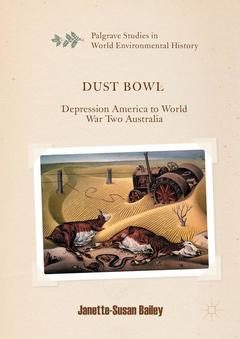Description
Dust Bowl, 1st ed. 2016
Depression America to World War Two Australia
Palgrave Studies in World Environmental History Series
Author: Bailey Janette-Susan
Language: English
52.74 €
In Print (Delivery period: 15 days).
Add to cartSupport: Print on demand
Description
/li>Contents
/li>Biography
/li>
This book takes the Dust Bowl story beyond Depression America to describe the ?dust bowl? concept as a transnational phenomenon, where during World War Two, US and Australian national mythologies converged. Dust Bowl begins with Depression America, the New Deal and the US Dust Bowl where massive dust storms darkened the skies of the Great Plains and triggered a major national and international media event and generated imagery describing a failed yeoman dream, Dust Bowl refugees, and the coming of a new American Desert. Dust Bowl traces the evolution of this imagery to Australia, World War Two and New Deal-inspired stories of conservation-mindedness, soil erosion and enemies, sheep-farmers and traitors, creeping deserts and human extinction, super-human housewives and natural disaster and finally, grand visions of a nation-building post-war scheme for Australia?s iconic Snowy River?that vision became the Snowy Mountains Hydro-electric Scheme.
Janette-Susan Bailey holds a PhD from the University of New South Wales, Australia and has a combined Honors degree in Film, Theatre and Performance Studies / Environmental Studies. She has a background in environmental performance writing and has been nationally and internationally recognized for her cross disciplinary approaches to historical research. She has published in international journals including Environment and History.



